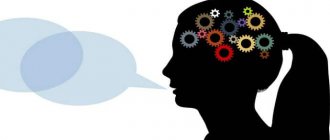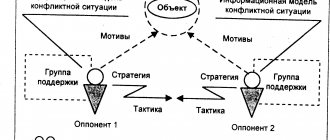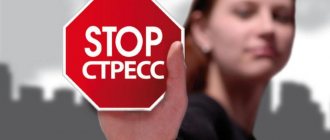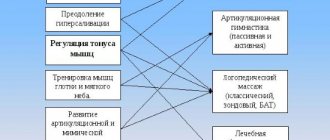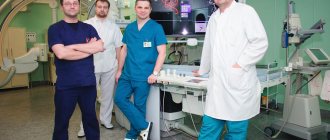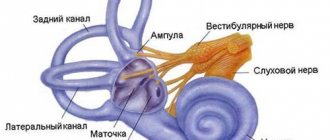Sudden loss of speech. Causes. Symptoms Diagnostics
In case of sudden loss of speech, first of all it should be determined whether it is anarthria (that is, the inability to pronounce words due to a violation of the coordinated activity of the respiratory, vocal and articulatory apparatuses due to their paresis, ataxia, etc.) or aphasia (that is, there is a violation of speech praxis).
This task is not easy, even when the patient is conscious and able to follow instructions, which generally rarely happens in acute pathology. For simple questions, it is possible to obtain “yes”/“no” answers, which with a 50% probability are answers at random. Moreover, even with aphasia, patients can grasp the meaning of what they hear exceptionally well, using the “key word” strategy, by which they understand the general meaning of the phrase thanks to existing situational (“pragmatic”) skills that do not suffer from speech impairment.
Examination using simple commands is difficult if the patient is hemiplegic and/or immobilized. In addition, coexisting apraxia may also limit the clinician's options. In the case of oral apraxia, the patient will not be able to follow even fairly simple instructions (for example, “open your mouth” or “stick out your tongue”).
The ability to read is difficult to study because reading requires intact responses to oral gestures and motor skills, but studying written language can help make the right decision. For right-sided hemiplegia, the following test is used: the patient is asked to arrange in the correct order the words of a complete sentence, which he receives in written form on separate sheets of paper, mixed together. However, in some cases, even an experienced aphasia specialist cannot immediately make the right decision (for example, when the patient does not even attempt to utter at least a sound). It should be remembered that over time, the picture can quickly change, and instead of the aphasia that the patient had at the time of admission, dysarthria, that is, a purely articulatory speech disorder, can quickly come to the fore. When making a diagnosis, the age of the patient plays an important role.
The main causes of sudden loss of speech:
- Migraine with aura (aphasic migraine)
- Stroke in the left hemisphere
- Postictal state
- Brain tumor or abscess
- Thrombosis of the intracerebral sagittal sinus
- Encephalitis caused by herpes simplex virus
- Psychogenic mutism
- Psychotic mutism
Migraine with aura
In young patients, migraine with aura can be suspected first of all. In these cases, there is the following typical combination of symptoms: acute or subacute loss of speech (usually without hemiplegia), accompanied by headache, which the patient has repeatedly experienced in the past and which may or may not be accompanied by changes in neurological status. If such a migraine attack occurs for the first time in a given patient, a study of the family history (if available) can provide useful information, since in 60% of cases the disease is familial.
An EEG most likely reveals a focus of slow-wave activity in the left temporo-parietal region, which can persist for 3 weeks, while neuroimaging does not detect any pathology. Pronounced focal changes in the EEG in the absence of abnormalities according to the results of a neuroimaging study on the 2nd day of the disease, in principle, make it possible to make the correct diagnosis, with the exception of cases of herpetic encephalitis (see below). The patient should not have cardiac murmurs, which may indicate the possibility of cardiogenic embolism, which can occur at any age. A possible source of embolism is identified (or excluded) using echocardiography. Listening to vascular murmurs over the neck vessels is less reliable than Doppler ultrasound. If possible, transcranial Doppler ultrasound should be performed. A patient suffering from migraine and belonging to the age group from 40 to 50 years may have asymptomatic stenotic vascular lesions, but the typical nature of the headache, rapid reversal of symptoms and the absence of structural changes in the brain according to the results of neuroimaging research methods in combination with the changes described above EEG allows a correct diagnosis to be made. If symptoms do not progress, there is no need for CSF testing.
Left hemisphere stroke
When speech impairment occurs in an elderly patient, the most likely diagnosis is a stroke. In most cases of speech impairment during a stroke, the patient exhibits right-sided hemiparesis or hemiplegia, hemihypesthesia, and sometimes hemianopsia or a defect in the right visual field. In such cases, neuroimaging is the only way to reliably differentiate intracerebral hemorrhage and ischemic stroke.
Loss of speech almost always occurs with a left-hemisphere stroke. It can also be observed with a right-hemisphere stroke (i.e., with damage to the non-dominant hemisphere), but in these cases speech is restored much faster, and the likelihood of complete recovery is very high.
Mutism may precede the appearance of aphasia with damage to Broca's area; it has also been described in patients with damage to the supplementary motor area and severe pseudobulbar palsy. In general, mutism often develops with bilateral lesions of the brain: the thalamus, anterior areas of the cingulate cortex, damage to the putamen on both sides, and the cerebellum (cerebellar mutism with acute bilateral damage to the cerebellar hemispheres).
Gross impairment of articulation can occur when there is a circulatory disorder in the vertebrobasilar area, but a complete absence of speech is observed only with occlusion of the basilar artery, when akinetic mutism develops, which is a rather rare phenomenon (bilateral mesencephalon damage). Mutism as a lack of vocalization is also possible with bilateral paralysis of the muscles of the pharynx or vocal cords (“peripheral” mutism).
Postictal state (state after a seizure)
In all age groups except infants, speech loss may be a postictal phenomenon. The epileptic seizure itself may go unnoticed, and the bite of the tongue or lips may be absent; An increase in the level of creatine phosphokinase in the blood may be an indication of a seizure, but this finding is unreliable in terms of diagnosis.
Quite often, diagnosis is facilitated by EEG: generalized or local slow and sharp wave activity is recorded. Speech is quickly restored, and the doctor is faced with the task of determining the cause of the epileptic seizure.
Brain tumor or abscess
In the history of patients with a brain tumor or abscess, any valuable information may be missing: there was no headache, there were no behavioral changes (aspontaneity, flattening of affect, apathy). An obvious inflammatory process of the ENT organs may also be absent. Sudden loss of speech can occur: due to the rupture of a vessel supplying blood to the tumor, and the resulting hemorrhage into the tumor; due to the rapid increase in perifocal edema; or - in the case of a left-hemispheric tumor or abscess - due to a partial or generalized epileptic seizure. Making a correct diagnosis is only possible with a systematic examination of the patient. It is necessary to conduct an EEG study, in which it is possible to register a focus of slow-wave activity, the presence of which cannot be unambiguously interpreted. However, the presence of very slow delta waves in combination with a general slowing of electrical activity in the brain may indicate a brain abscess or a hemispheric tumor.
With computed tomography, both in the case of a tumor and in the case of an abscess, it is possible to identify a large intracerebral process in the form of a low-density focus with or without contrast uptake. With abscesses there is often more pronounced perifocal edema.
Thrombosis of the intracerebral sagittal sinus
There is the following typical triad of symptoms that may indicate thrombosis of the intracerebral sinus: partial or generalized epileptic seizures, hemispheric focal symptoms, decreased level of wakefulness. The EEG records generalized low-amplitude slow-wave activity over the entire hemisphere, also extending to the opposite hemisphere. With neuroimaging, sinus thrombosis is indicated by hemispheric edema (mainly in the parasagittal region) with diapedetic hemorrhages, signal hyperintensity in the area of the sinus(es) and a deltoid-shaped zone that does not accumulate the injected contrast and corresponds to the affected sinus.
Encephalitis caused by herpes simplex virus (HSV)
Because herpetic encephalitis caused by HSV primarily affects the temporal lobe, aphasia (or paraphasia) is often the first symptom. The EEG reveals focal slow-wave activity, which, upon repeated EEG recording, is transformed into periodically occurring three-phase complexes (triplets). Gradually, these complexes spread to the frontal and contralateral leads. Neuroimaging identifies a low-density zone, which soon acquires the characteristics of a volumetric process and spreads from the deep parts of the temporal lobe to the frontal lobe, and then contralaterally, primarily involving areas related to the limbic system. Signs of an inflammatory process are found in the cerebrospinal fluid. Unfortunately, verification of HSV infection by direct visualization of viral particles or using immunofluorescence analysis is possible only with a significant time delay, while antiviral therapy should begin immediately when the first suspicion of viral encephalitis arises (taking into account the fact that the mortality rate of HSV- encephalitis reaches 85%).
Psychogenic mutism
Psychogenic mutism is manifested by the absence of responsive and spontaneous speech while maintaining the ability to speak and understand speech addressed to the patient. This syndrome can be observed in the picture of conversion disorders. Another form of neurotic mutism in children is selective (selective, occurring when communicating with only one person) mutism.
Psychotic mutism is mutism in the picture of negativism syndrome in schizophrenia.
Diagnostic tests for sudden speech loss
General and biochemical blood test; ESR; ocular fundus; cerebrospinal fluid examination; CT or MRI; Doppler ultrasound of the main arteries of the head; A consultation with a neuropsychologist can provide invaluable assistance.
Medical portal. students, doctors, medical books
Speech disorders can be divided into two groups - dysarthria
and
aphasia
. Dysarthria occurs with lesions of the peripheral, executive apparatuses that provide speech: paralysis or paresis of the muscles of the vocal cords, tongue, soft palate, which occurs when both cortico-nuclear connections are damaged, which, like cortico-spinal connections, begin mainly from the anterior central gyrus of the brain (Fig. . 100), and due to damage to the peripheral nerves themselves (VII, IX, X, XII), as well as disruption of their connection with the cerebellum and subcortical nodes. In this case, speech becomes incomprehensible, blurred, disfigured, but its grammatical structure is not disturbed.
Aphasia
(from the Greek phase - speech, and - negation) is a disorder of speech activity that occurs with organic lesions of the left (for right-handed people) hemisphere, not associated with motor defects of the speech muscles or disorders of elementary hearing.
Thus, aphasia is significantly different from dysarthria (see Bulbar and pseudobulbar syndromes). This difference can be represented figuratively in the following comparison: with motor aphasia, the production of words is damaged, and with dysarthria, there is sufficient production of words and phrases, but there is nothing to display the production on.
Impairment of active speech is called motor aphasia, impairment of speech perception is called sensory aphasia.
Motor aphasia
. The first attempt to explain motor aphasia was made in 1861 by the outstanding French anatomist and anthropologist Broca, who noted that in these cases there is softening in the posterior parts of the inferior frontal gyrus of the left hemisphere, in the 44th and 45th cortical fields of the modern designation (see Fig. 21). However, negative cases, i.e. the presence of motor aphasia with intact cortical fields 44 and 45 or, conversely, almost intact speech with damage to these fields, convincingly showed that here we cannot talk about strict localization of functions, in this case the function of speech, but it is necessary think about the significance of the left frontal lobe of the brain, its posterior parts or postcentral region, in the activity of the functional speech system.
Depending on the predominant localization of the lesion, the patient will have either afferent motor ( kinesthetic)
), or efferent (
kinetic
) motor aphasia, or another type - dynamic motor aphasia (
We present a division of aphasias according to the works of Academician of the Academy of Pedagogical Sciences of the USSR A.R. Luria. There are other classifications of aphasias, but this one, based on the analysis of speech development, is better others correspond to anatomical and clinical data
).
Afferent motor aphasia
is caused by blockade of incoming afferent proprioceptive impulses from the postcentral gyrus.
The absence of reverse afferentation deprives the patient of the ability to quickly and without tension, purely automatically, articulate sounds and words. Control of the articular act
is confusing, loses its clarity and selectivity, as a result of which the patient does not immediately find the desired positions of the tongue and lips. The distinction of words is broken, instead of one word a distorted other word that is consonant with it pops up, distorting the meaning (hump - coffin, horns - mountain, mountain - bark). Here repeated speech, reading, especially loudly, and writing are grossly violated. The understanding of speech is also impaired to some extent, which is why the patient does not notice his verbal mistakes.
Efferent motor aphasia
observed with damage in Broca's area (cortical areas 44 and 45). Unlike afferent motor aphasia, with efferent motor aphasia the articulation of individual sounds is not impaired. However, the process of switching from one speech unit (sound, word) to another suffers. Outwardly, this manifests itself as so-called perseveration - getting stuck on one letter (literal perseveration) or on a word (verbal perseveration). So, for example, having started to say the word “flour” and saying “mu”, the patient cannot move to the syllable “ka”, but helplessly pronounces “mu...mu...mu...ma”. Or having successfully said the word “table” when asked to immediately say the word “dad”, he repeats: “table... table... eh... yes... ext... ext...dad.”
These difficulties in switching from word to word, or so-called verbal emboli, play a significant role in the picture of pronounced efferent motor aphasia and represent a very significant obstacle to the establishment of normal speech in such patients.
Another distinctive feature of speech in efferent motor aphasia is the “telegraphic style” of speech. Speech consists mainly of nouns, verbs are almost entirely absent. Automatic speech, swearing, singing, and less often poetry remain relatively preserved. Repetition is impaired less severely than in afferent motor aphasia.
For dynamic motor aphasia
(damage to the zone located anterior to Broca's area), spontaneous speech suffers, while the repetition of words and phrases is preserved. According to A. R. Luria, this form of aphasia is based on a violation of internal speech, the main function of which is programming and structuring sentences.
Sensory
(temporal)
aphasia
was first described in 1874 by A. Ya. Kozhevnikov and in the same year clarified by the German neurologist and psychiatrist Wernicke, who associated it with a lesion in the posterior part of the left superior temporal gyrus.
Clinical observations indicate that in milder cases the patient understands individual words and even some phrases, especially those related to daily routine, but a phonemic hearing disorder may be observed. A phoneme is a semantically distinctive feature of a language, for the Russian language it consists of voicedness and deafness (b-p, d-t, z-s), stressed and unstressed (mukA and muka, zamOk and zamok), hardness and softness (table and so, chalk and strand). In severe cases, the patient does not understand human speech at all; the word for him loses its meaning and is perceived as a combination of unclear noises. The patient's spontaneous speech is also grossly impaired. The lack of auditory afferentation and auditory control of one’s own speech leads to the fact that words are pronounced incorrectly, often one sound (letter) is replaced by another - literal paraphasia
.
In the same way, one word can be replaced by another, which is called verbal paraphasia. As a result, speech becomes incomprehensible. It should be added that, unlike patients with motor aphasia, who prefer silence, those suffering from sensory aphasia are often extremely talkative. This condition was even called logorrhea
(“verbal diarrhea”). It can be very difficult to understand the stream of distorted words and sounds (“verbal hash”). Only the intonations remain intact, from which one can guess what the patient wants.
Forgetting words, or rather, the phenomenon of alienation of meaning, words, manifests itself not only in errors in spontaneous speech, but also in attempts to find the name of objects shown to the patient; However, prompting the beginning of words does not lead to successful results. Even with milder forms of sensory aphasia, when the patient can show his nose, ear, and eye without much difficulty, he turns out to be helpless in cases of a complicated task - show the nose and eye, touch the ear with his right hand, etc.
With damage to the secondary parts of the temporal cortex, corresponding to Brodmann's areas 22, 37, another type of temporal aphasia is observed, the so-called acoustic-mnestic aphasia
when auditory-verbal memory is impaired, that is, the patient does not recognize words by hearing, but speaks well and often has preserved reading and writing.
Amnestic and semantic aphasia
.
amnestic aphasia
identified by some authors as an independent form , observed with lesions in the region of the temporo-parietal junction. The patient “forgets” a word, most often nouns, i.e., the name of objects. In spontaneous speech, he deftly replaces a forgotten word with another or a description of a given object, but turns out to be helpless if he is asked to name the objects being shown. Instead of “pencil” he says “what one draws with”, instead of “spoon” he says “what one eats with”. However, as soon as the patient is prompted with the first syllable, and sometimes even purses his lips to pronounce it, the patient remembers the word and pronounces it well, but immediately forgets it.
Semantic aphasia is often combined with amnestic aphasia.
(semantic)
aphasia
. The patient seems to speak well and understand words, but is lost during more complex speech tasks that require logical comparison and reasoning. He cannot grasp the semantic relationship of individual concepts, for example, he does not grasp the difference between such expressions as “father’s brother” and “brother’s father,” helplessly repeating “brother ... father ...”, or “daughter’s mother” and “mother’s daughter.” Disturbances in spatial relationships are especially pronounced in patients. For example; the phrase “I went for a walk after I had lunch” is understood by the patient in the sequence of presentation, i.e. “I went for a walk and then had lunch.” It is difficult for the patient to understand such spatial definitions as under or above something, near something or someone, on the right, on the left. The relationships “with what, by whom” are completely incomprehensible to him, for example, “stir tea with a spoon”, “the table is made by a master.” Counting operations often go wrong here. Within single-digit numbers, the patient still copes with the task, but if he moves to multi-digit numbers, he begins to get confused, writing all the numbers separately or dividing them into digits. So, 1015 is written by him as 1000-15 or 115. The patient shows complete helplessness and confusion when explaining well-known sayings or proverbs, trying to get rid of the investigator’s annoying questions with some remarks, like: “Why are you making a fool out of me.”
Alexia, agraphia, acalculia, amusia
. Disorders of reading, arithmetic and writing - alexia, acalculia and agraphia - are included in the concept of aphasia. However, it should be noted that sometimes there is a very significant reading impairment with relative preservation of speech.
The destruction of one of the links that are part of complex functional systems that ensure the performance of the acts of reading, counting and writing when the pathological focus is localized, for example, at the junction of the occipital, temporal and parietal regions, leads to a disruption in the formation of corresponding images and associated verbal designations, in as a result, letters and numbers become meaningless signs and, consequently, reading and counting becomes impossible. Alexia and acalculia occur. Writing is also impaired (agraphia). When you try to write on paper, scribbles appear that have no resemblance to letters or numbers or very vaguely resemble them.
The location of the pathological focus in the temporal region, which causes the development of sensory aphasia, is also accompanied by a writing disorder. In this case, copying text and the usual forms of writing (own signature) usually do not suffer, but the patient cannot write under dictation or, especially, independently.
A completely different nature of writing disorders is observed with damage to the precentral region of the left hemisphere. Writing individual letters in this case does not present any special difficulties, but the patient finds it difficult to maintain their sequence, the transition from one letter to another is disrupted, and their repetition is noted (motor perseveration).
Thus, the violation of the same function is of a different nature with different localization of the lesions and is a clear illustration of how violations of different aspects of the same function arise when different components of the complex functional system that determines the act of writing are included.
Amusia, i.e., a disorder of musical abilities, based on clinical observations, is associated with damage to the frontal regions of the right hemisphere. Patients even with total aphasia (i.e., with extensive lesions in the left hemisphere of the brain) can hum a melody quite accurately. On the other hand, damage to the right hemisphere is accompanied by a loss of the ability to create music.
Information provided by medvuz.info
Similar articles
- Fundamentals of the doctrine of higher brain functions
- Agnosia, apraxia, body diagram disturbances
Add to bookmarks
Causes of speech disorders in adults
Speech impairment in adults is a pathology that manifests itself in the complete or partial absence of speech.
In a conversation with a person suffering from such an illness, it is impossible to understand what he is saying or asking; his words are illegible and unclear.
This pathology manifests itself differently in each person. In some people, such violations cause hasty, but completely meaningless speech, while others, on the contrary, construct sentences logically and constructively, but at the same time speak very slowly and unhurriedly.
The main causes of speech impairment in adults:
- Previously suffered brain injuries;
- The presence of benign or malignant formations in the brain;
- Parkinson's disease;
- Multiple sclerosis;
- Wilson's disease;
- Alcohol abuse.
Banal dentures can also be a cause. If it is not properly secured, older people experience dysfunction of the speech apparatus.
Speech impairment in an adult can also occur due to diseases that cause paresis of the facial muscles.
Paresis is a neurological syndrome indicating a decrease in strength. Such diseases include Millard-Jublet syndrome, Mobius syndrome, muscle agenesis, Beck's disease and Sjögren's syndrome.
Myasthenia gravis can also cause problems. This is an autoimmune neuromuscular disease that is characterized by pathologically rapid fatigue of the transverse sucking muscles.
Doctor diagnosing speech disorders in an adult
Some diseases cause not only paresis of the facial muscles, but also impaired articulation and speech in adults.
This pathology occurs with Foix-Chavanne-Marie syndrome. With this disease, the middle cerebral artery basin is affected.
One of the most common causes of speech impairment in adults is Alzheimer's disease.
With this disease, dementia (acquired dementia), partial memory loss, and articulation difficulties are observed. Most often, this disease affects people over 65 years of age.
There are the following types of speech disorders in adults:
- Dysphonia;
- Aphonia;
- Bradylalia;
- Tahilalia;
- Stuttering;
- Dislalia;
- Dysarthria;
- Alalia;
- Aphasia.
Spasmodic dysphonia
This pathology is more common in people aged 30 to 40 years. Dysphonia is a voice disorder characterized by hoarseness.
Spasmodic dysphonia occurs due to prolonged overstrain of the vocal cords.
Also, the cause of this pathology may be mental trauma.
With this form of dysphonia, pain is observed in the neck and head muscles, and the timbre of the voice changes significantly. The disease manifests itself in slurred speech and difficulty pronouncing certain sounds.
Aphonia
Aphonia is a pathological condition with loss of vocal sonority.
With this pathology, a person remains able to speak in a whisper, but when speaking he experiences a sore throat.
Aphonia occurs due to bronchial diseases or laryngitis. This pathology can also occur with prolonged screaming or intubation.
Bradylalia
Bradylalia is a disturbance in the rate of speech production. In other words, with this disease the rate of speech is very slow. Articulation in bradyllalia is unclear.
Fear in a person due to speech disorders
This disease occurs due to Parkinson's disease, brain tumors, meningitis and encephalitis.
Bradylalia can also be hereditary or appear after brain injury.
Tahilalia
Tahilalia is a disorder that manifests itself in a fast pace of oral speech.
With this disease, a person does not make grammatical or phonetic errors in pronunciation.
The causes of tachyhalea can be:
- Chorea disease.
- Epilepsy.
- Oligophrenia.
- Skull injuries.
- Heredity.
- Formations in the brain.
- Myelitis.
- Tetanus.
- Arachnoiditis.
Stuttering
Stuttering is a disease that manifests itself in the form of impaired speech function.
When a person stutters, he stretches out syllables and pronounces words incorrectly.
Causes:
- Brain damage.
- Stress.
- Heredity.
Dislalia
With dyslalia, a person reproduces sounds incorrectly. This disease appears due to the presence of a defect in the structure of the speech apparatus (bad bite, shortened hyoid frenulum, abnormal structure of the palate, and others).
The occurrence of speech disorders after a stroke
Dyslalia also occurs due to illiterate speech education or in connection with mental development disorders.
Most often, this disease occurs in children, but it also occurs among adults. In adults, dyslalia appears due to low mobility of the speech apparatus.
Dysatria occurs due to damage to the central part of the speech motor analyzer.
With this disease, there is a disorder of articulation, phonation and speech.
Dysatria occurs due to cerebral palsy, neurosyphilis, multiple sclerosis and myotonia.
A similar speech disorder occurs in adults with a stroke and after neurosurgical operations.
Alalia
Alalia is an underdevelopment of speech due to damage to the speech centers of the brain.
The main reasons for the appearance of alalia in people over 20 years of age are operations using general anesthesia, previous traumatic brain injuries and malnutrition.
Aphasia is a complete or partial loss of the ability to reproduce words and sounds. This disease occurs due to damage to the cerebral cortex.
Aphasia appears due to impaired blood circulation in the brain, with the formation of a brain abscess, after strokes and heart attacks.
Affected areas of the cerebral cortex in aphasia
Epilepsy or acute intoxication with toxic substances can also cause the development of the disease.
A patient with aphasia has difficulty recognizing speech, has problems concentrating, and has problems reading and remembering.
Treatment of speech disorders
Treatment for speech disorders in adults is selected based on the type of disorder itself.
Treatment mainly involves massage, physiotherapy, exercise therapy and medication.
Medication
Treatment of dysarthria involves exercise therapy and medication. It is very important that the patient’s treatment is also accompanied by a speech therapist.
Drugs for the treatment of dysarthria:
- "Piracetam."
- "Finlepsin".
- "Lucetam."
If an adult has inhibited speech after a stroke, that is, dysarthria, then it is necessary to do daily language exercises.
To treat aphasia, nootropic drugs and drugs that improve microcirculation in brain tissue are used.
Preparations:
- "Vinpocetine."
- "Piracetam."
For aphasia, working with a speech therapist is mandatory. Typically, to fully restore the ability to speak, you will need to be treated by a speech therapist for at least 3 years.
Piracetam - for the effective treatment of speech disorders
Stimulant medications are prescribed to treat dysphonia:
- ATP.
- Prozerin.
- Tranquilizers.
Other drugs for the treatment of speech disorders:
- "Vinpotropil."
- Cavington.
- "Memotropil."
- "Nootropil"
Medical therapy should include medications that improve memory and enhance metabolic processes in the central nervous system.
It is extremely rare that surgery is used to treat such diseases. Surgery is necessary to remove tumors and other formations that provoked the disorder.
Speech impairment in an adult after stress requires not only exercise therapy and medication, but also a visit to a qualified psychotherapist or psychologist. It is likely that the person himself, after experiencing the situation, on a subconscious level put a barrier to speech reproduction.
Treatment at home
Traditional medicine can also be used to treat speech disorders.
If a person has dysarthria, then the following recipe will help: 1 tbsp. l. dill seeds are poured with boiling water and infused for 15 - 20 minutes.
Then the infusion is filtered and cooled. It should be taken 15 minutes before meals in the amount of 1 tsp. Use the product no more than 5 times a day.
If an elderly person has slow speech, for example, after a stroke, then you can make a tincture of ginseng, buckwheat and Echinops.
Rehabilitation of the consequences of speech disorders
For dysphonia (temporary loss of voice), it is recommended to gargle with water and lemon juice.
Exercise therapy plays a major role in the treatment of speech disorders. The patient should do exercises daily if the cause of the disorder is paresis of the facial muscles.
- exercise: stretch your lips, curling them into a tube. Hold in this position for 5 seconds, then repeat;
- exercise: grab the upper lip with your lower jaw, hold it for 3 seconds, then release;
- exercise: close your mouth. The tongue reaches the palate.
Conclusion
Treatment of a speech disorder is a long process. It is very important that, along with doctors and speech therapists, the patient is helped at home.
People with such problems should express their thoughts clearly and slowly, and not be negative or dismissive.
Aphasia - complete or partial loss of speech caused by local brain lesions
Aphasia. Neurolinguistic approach. Causes and mechanisms. Classification. Differential diagnosis.
Alalia. Definition. Etiology. Classification. Differential diagnosis.
Among preschool children, alalia occurs in approximately 1%, and among school-age children in 0.6-0.2%. On average, we can assume that alalia occurs in 0.1% of the population. In boys, this disorder occurs 2 times more often than in girls.
Alalia is a systemic underdevelopment of speech, in which all components of speech are disrupted: the phonetic-phonemic side, the lexical-grammatical structure. Among non-speech disorders in alalia, motor, sensory, and psychopathological symptoms are distinguished.
The causes of alalia syndrome are varied. Etiopathogenetic factors can act at different periods of child development. In the prenatal period, the causes of alalia can be intoxication, chronic diseases of the mother, circulatory disorders of the fetus, bruises and falls of the mother with subsequent trauma to the fetus, unfavorable course of pregnancy with the threat of miscarriage, congenital complications (diseases of the parents, such as tuberculosis, syphilis, etc. ). The action of unfavorable factors in the prenatal period not only causes organic brain damage and adversely affects the development of the fetus, but also negatively affects the course of childbirth. In the natal period, the causes may be: pathology of childbirth (unsuccessful use of obstetric aids, prolonged or rapid labor, the birth of a child with a birth tumor, hematoma, asphyxia, etc.). The action of such factors can cause disruptions in the formation of intersystem brain connections necessary for the timely and complete development of speech. In the postnatal period of development, early head injuries, infectious hepatitis, meningitis, meningoencephalitis, long-term somatic diseases, a chain of childhood infections that cause depletion of the central nervous system and negatively affect its development can have a negative impact. In addition to the action of biological factors, in the postnatal period of development, the action of socio-psychological factors is also possible, such as: insufficiency of speech and intellectual contacts, conflictual relationships in the family, incorrect methods of education, hospitalism, an environment consisting of people with speech pathology, multilingualism in the family and etc. However, the leading causes of alalia should be considered biological; socio-psychological ones only aggravate speech failure.
The symptoms of alalia are quite diverse and are not limited to impaired speech function. The nature of alalic syndrome in each specific case will have individual characteristics and will depend on the location and severity of the organic lesion, the general somatic condition of the child, his age, intellectual capabilities, and his environment. Alalia syndrome consists of neurological, psychopathological and speech symptoms.
Alalia classification:
Topological (clinical) classification:
This classification is based on the criterion of taking into account the localization of brain damage in alalia.
Motor alalia (caused by disorders of the central (cortical) section of the speech motor analyzer). The child begins to understand other people’s speech in a timely manner, but his own speech does not develop. R. A. Belova-David, studying children with motor alalia, depending on which part of the speech motor analyzer was affected, identified motor afferent and motor efferent alalia.
Afferent motor alalia is caused by pathology of the postcentral zone of the cerebral cortex (lower parietal part of the left hemisphere), which is normally responsible for kinesthetic analysis and synthesis of stimuli, sensations entering the brain during speech, and for kinesthetic speech programs.
Efferent motor alalia is caused by pathology of the premotor zone of the cerebral cortex (posterior third of the inferior frontal gyrus - Broca's area), which is normally responsible for the sequence and organization of complex complexes of motor programs.
Sensory alalia (caused by damage to the central part of the speech-hearing analyzer). It is characterized by the fact that while elementary hearing is preserved, the child does not master the understanding of speech. In this case, the posterior third of the superior temporal gyrus, Wernicke’s center, is affected. This form of alalia is not highlighted by all authors.
· Sensorimotor alalia (combines the signs of motor and sensory alalia)
· Optical alalia. This form is also not emphasized by all authors. It is caused by the inferiority of the speech-visual analyzer (occipital region of the left hemisphere). At the same time, the understanding and use in speech of logical-grammatical constructions, which are based on spatial and temporal representations, are impaired. The understanding and assimilation of prepositional constructions, comparative constructions, and adverbs is also impaired.
Differential diagnosis of alalia with oligophrenia, RDA, physiological hearing impairment.
Question No. 51
Organization and content of correctional and educational interventions for various forms of alalia
Depending on the nature of the disorder, this problem is solved differentially in relation to motor and sensory alalia.
An integrated approach to the formation of speech during alalia directs attention to the formation of all functions of speech that contribute to its development and improvement of cognitive activity.
Comprehensive systematic work is being carried out on speech and personality as a whole, taking into account the patterns of development of speech function in ontogenesis and the patterns of language structure.
The work is aimed primarily at creating mechanisms of speech activity: the formation of a motive, communicative intention, internal program of an utterance, its lexical layout, selection of lexical and grammatical means, grammatical structuring. To enrich speech practice, skills in the conscious use of knowledge are developed, and mastery of modeling speech operations is developed.
In the works of L. S. Vygotsky, A. N. Leontyev, A. R. Luria, A. V. Zaporozhets, P. Ya. Galperin and other researchers, a general theory of activity and its provisions was developed: about external objective activity as its genetically initial form, about the emergence of internal mental actions from external processes, about the active, controlled process of the formation of mental activity through a change in the structure of external activity. Based on this, the work uses the correctional capabilities of subject-based practical activities, practical actions that have cognitive significance.
Effective for speech development is the use of rhythmic and logorhythmic techniques, when music, words and movement, combined in various exercises, form motor and speech motor activity, memory, and ensure that gaps in the rhythmic, speech and personal development of children are filled.
To develop speech, it is necessary to practice communication at a level accessible to the child.
At the first stage of work, the main thing is the education of speech activity, the formation of a passive and active vocabulary that is accessible to understanding and reproduction. Work is being done on dialogue, a short simple story, uncommon, then common sentences, the psychophysiological prerequisites for speech activity and initial skills in a communication situation are being formed.
At the second stage, phrasal speech is formed against the background of increasing complexity of the vocabulary and phrase structure. Work is underway on the distribution of sentences, their grammatical design, on dialogue and narrative stories of a descriptive nature, and utterances are formed as the basic units of speech action.
At the third stage, the main thing is the formation of coherent speech - particularly complex communicative activities, communication skills, automation of grammatical structures. At each stage, all aspects of speech activity are formed.
Children with alalia begin to learn to read and write relatively early, this expands their speech capabilities. Read and written material is better consolidated and the formation of speech activity is ensured. Literacy helps a child master the structure of words and phrases; through reading and writing, he controls and corrects his speech. Teaching literacy to such children requires lengthening the time frame and using special techniques. When mastering written speech, secondary dysgraphia and dyslexia are revealed.
Positive dynamics in alalia are revealed by taking into account the following factors: early recognition of underdevelopment, timely prevention of secondary deviations, taking into account normal ontogenesis, systematic impact on all components of speech with a primary emphasis on overcoming lexical and grammatical underdevelopment, differentiated approach to children, speech formation with simultaneous impact on sensory-intellectual and affective-volitional sphere, the unity of the formation of speech processes, thinking and cognitive activity, etc.
Question No. 52
The causes of aphasia are cerebral circulation disorders (ischemia, hemorrhoids), trauma, tumors, and infectious diseases of the brain. Aphasia of vascular origin most often occurs in adults. As a result of rupture of cerebral aneurysms, thromboembolism caused by rheumatic heart disease, and traumatic brain injuries, aphasia is often observed in adolescents and young adults.
Aphasia occurs in about a third of cases of cerebrovascular accidents, with motor aphasia being the most common.
In children, aphasia occurs less frequently, as a result of traumatic brain injury, tumor formation, or complications after an infectious disease.
Aphasia is one of the most severe consequences of brain damage, in which all types of speech activity are systematically impaired.
. The complexity of the speech disorder in aphasia depends on the location of the lesion (for example, the location of the lesion during hemorrhage in the subcortical regions of the brain allows us to hope for spontaneous restoration of speech), the size of the lesion, the characteristics of the residual and functionally preserved elements of speech activity in left-handed people. The reaction of the patient’s personality to a speech defect and the characteristics of the premorbid structure of the function (for example, the degree of automation of reading) determine the background of rehabilitation training.
The basis of any form of aphasia is one or another primary impaired neurophysiological and neuropsychological prerequisite (for example, a violation of dynamic or constructive praxis, phonemic hearing, apraxia of the articulatory apparatus, etc., which leads to a specific systemic disorder in the understanding of speech, writing, reading, accounts). With aphasia, the implementation of different levels, aspects, types of speech activity (oral speech, speech memory, phonemic hearing, speech understanding, written speech, reading, counting, etc.) is specifically systematically impaired. A major contribution to the understanding of speech impairment in aphasia has been made by neurophysiology, neuropsychology and neurolinguistics.
The basis of modern neuropsychology and neurolinguistics is the doctrine of the role of inner speech and thinking. At the origins of psycholinguistics are the names of F. de Saussure and I. A. Baudouin de Courtenay, who laid the foundation for the differentiation of the concepts of “language” and “speech”, “paradigmatic” and “syntagmatic” relations, “statics” of language and “dynamics” of speech.
Paradigmatic units of speech mean all the features of a language: phonemes, syllabic system, vocabulary, prefixes, suffixes, certain phrases, i.e., what characterizes a particular language
.
Each paradigm, for example, a phoneme, has a certain number of features, the replacement of which changes the semantic quality of the phoneme, therefore paradigmatic features are characterized by the principle of interchangeability “or” - “or”: either oral, or nasal, or labial, or lingual, or voiced, or voiceless . These contrastive features distinguish phonemes and lexemes (arrive - leave, house
-
house
, etc.). In speech, all paradigmatic units are interconnected syntagmatically according to the “and” - “and” principle, which does not allow interchangeability; Thus, in a word, phonemes have their own rigid, linear order; in a sentence, a preposition cannot appear before a verb or adverb, etc., i.e., paradigmatic relationships are built according to the spatial, simultaneous principle, and syntagmatic ones - according to the temporal, linear, successive principle principle. In different forms of aphasia, the “paradigmatic” and “syntagmatic” organization of impressive and expressive speech is impaired in different ways (A. R. Luria, 1975).
A. R. Luria distinguishes six forms of aphasia: acoustic-gnostic and acoustic-mnestic aphasia, arising from damage to the temporal parts of the cerebral cortex, semantic aphasia and afferent motor aphasia, arising from damage to the lower parietal parts of the cerebral cortex, efferent motor aphasia and dynamic aphasia that occurs when the premotor and posterior frontal parts of the cerebral cortex are damaged (on the left in right-handed people).
Aphasia that occurs with damage to the superior temporal and inferior parietal zones included in the second functional block (A. R. Luria, 1979) is called “posterior” forms of aphasia. These are aphasias in which paradigmatic relationships are disrupted. Aphasias that occur when the posterior frontal parts of the brain, which are part of the third functional block, are damaged are called “anterior” aphasias. In these forms of aphasia, syntagmatic relationships are disrupted.
Question No. 53
Speech incoherence
This article is about the complete grammatical incoherence of speech. For grammatically correct but meaningless speech, see Schizophasia.
Speech incoherence (also known as speech incoherence or incoherence, speech confusion, verbal “okroshka”, verbal “salad”) is a speech disorder in which grammatical connections are disrupted and the speech itself consists of a jumbled set of words. Occurs when there are phenomena of incoherent thinking with the inability to create associations, individual concepts, images and perceptions. According to the classification, it belongs to effector speech disorders, namely speech disorders caused by psychopathological disorders.
An example of such a speech:
- How are you feeling? - Where is Petya... I went and slept. What do they want? And yesterday it was... everything is there... - Where are you? - You are... everyone is here. Turn off the light. Where's the wife? I went... So how? I lost my glasses. My wife came to go again yesterday. Let's get out of here... Everything is fine. — What is today’s date? - The date... is always winter (the conversation takes place on a hot summer day). - What year is it now? — The year is 1924 (names the year of his birth). Senya was... The Moscow fire was noisy and burning... Well, that was fine... Where is the tie?..
— Bleicher V. M. Incoherent thinking // Disorders of thinking. - K.: Health, 1983.
Unlike schizophasia, the grammatical structure is completely disrupted. The answers are inadequate to the questions, and it is impossible to understand even a remote connection in the sentence. It is more common in exogenous processes, namely amentia, sometimes in endogenous processes (schizophrenia). The peak of verbal okroshka occurs when the patient utters only a set of words: “trauma, movement, motor...” or even meaningless neologisms (more typical for schizophrenia): “77 is the mistress of everyone... Khyumala, rumala, pyumala... Sewed... Cooled down... Fuck... Explosion ... Pan, pan, pan... Times, events, people... above me is Kashchei the Besfamilny... Lockheed Elevator acquired... And my mother is so young, Volodenka I... t-ball and nif... fluff and dust...”
The etymology of the term “verbal okroshka” comes from a traditional Russian dish in which a wide variety of ingredients are finely crumbled. A similar definition is “word salad.”
Homework
My father recently suffered a stroke. Speech was affected. He is working with a speech therapist, but the problems are going away slowly. Tell me, is there anything the patient’s relatives can do to help in this situation?
Margarita, Magnitogorsk
Doctor of Medical Sciences, employee of the Research Institute of Neurology of the Russian Academy of Medical Sciences Natalya Shakhparonova answers:
– Relatives and friends of the patient after a stroke should talk to him as much as possible. Even discussing ordinary everyday situations greatly contributes to the patient’s restoration of both understanding the speech of others and “speech to oneself.” If it seems that you were not understood, you need to repeat the question addressed to the patient, while speaking clearly, loudly and slowly.
It is useful to listen to the radio and watch TV shows together, incomprehensible parts of which need to be clarified at first. Even discussing household chores and small events in the presence of the patient will contribute to the restoration of his speech.
In this case, relatives should rely on those speech functions that the stroke survivor has preserved in whole or in part. If it’s understanding the speech of others, you need to speak more yourself; if it’s reading, you need to discuss what you read during the day. If the patient repeats words and phrases well, you need to focus on these activities.
Notes
- Morozov G.V., Shuisky N.G. Introduction to clinical psychiatry (propaedeutics in psychiatry). - Nizhny Novgorod: Publishing House NGMA, 1998. - P. 105. - 426 p. — 3000 copies. — ISBN 5-86093-010-0.
- Gavenko V. L., Bitensky V. S., Abramov V. A., Vlokh I. Y., Kozhina G. M., Korostiy V. I., Mozgova T. P., Napreenko O. K., Samardakova G. O., Sinaiko V. M., Spirina I. D., Yur'eva L. M. Psychiatry and narcology (textbook) = Psychiatry and narcology (handbook) / Ed. V. L. Gavenka, V. S. Bitenskogo.. - Kiev: Health, 2009. - P. 92. - 512 p. — 1000 copies. — ISBN 978-966-463-022-8.
- Bitensky V. S., Goryachev P. I., Melnik E. V. and others. Damage to information and self-esteem. Transient psychopathological syndromes. // Psychiatry: Course of lectures: Textbook = Psychiatry: Course of lectures: Basic handbook / Ed. Bitensky V.S. - Odessa: ONMU, 2004. - P. 86. - 354 p. — 75,000 copies. — ISBN 966-7733-56-4.
- Kirpichenko A. A. Thinking disorders // Psychiatry: Textbook for medical institutes. - Minsk: Higher School, 1984. - P. 22-23. — 240 s. — 25,000 copies.
| Speech incoherence | ICD-11 | |
| This is a draft article on psychiatry. You can help the project by adding to it. | ||
Causes and risk factors
Classification of a pathological condition involves division into organic and functional. The disorder may be a consequence of central nervous system dysfunction and hearing impairment. Also, its occurrence is caused by injuries and bruises of the head, damage to the speech organs. This could be a brain tumor, stroke, thrombosis. In older people, there is a connection with Alzheimer's and Parkinson's diseases. In this case, pathological memory disorders and mental disorders occur in parallel. Less commonly, epilepsy, alcohol abuse, cerebral palsy, and infectious diseases of the brain contribute to dysfunction.
The functional causes of speech disorder are considered to be external factors, for example, stress, fear, hysteria, untreated pathology from childhood. Under the influence of taking certain medications (antidepressants, tranquilizers), auditory perception may decrease, which aggravates speech disorders. An important role is played by the hereditary factor. If there is a predisposition, it is necessary to monitor the person’s condition over time.
The simultaneous influence of external and internal causes is possible, in which case the picture of disorders becomes multi-layered and manifests itself in a large number of symptoms.
A person’s communication functions also suffer when dentures are installed incorrectly. A deep state of stress and overexertion can lead to spastic dysphonia. In this case, tension in the voice or its disappearance is noted.
The necessary impulse
A new technique that determines the level of constant potentials in the brain (CBP) allows doctors to assess the level of metabolism in different parts of the brain tissue. Higher SMR values indicate increased energy expenditure in some area of the brain and high glucose consumption. Using these markers, one can judge the presence or absence of a reserve in certain areas, which helps doctors select an individual drug therapy regimen for the patient.
The study of evoked potentials of the brain provides information about the state of the patient’s cognitive functions and allows us to judge the degree of their rehabilitation during the treatment process. This technique consists of delivering specific electrical impulses to different parts of the brain and recording its response bursts of electrical activity.
Transcranial magnetic stimulation is a method that allows, by stimulating the brain, to obtain a motor response of any muscle in the body and to “calculate” the time it takes for the signal to travel from the cerebral cortex to the nerve roots that stimulate muscle contraction. With the help of these studies, it is possible to give a preliminary prognosis for the restoration of certain functions in the patient.
Classification of disorders in adults
Similar to childhood dysfunctions, pathology is divided into types according to its manifestations and symptoms. Experts identify the following expressive speech disorders:
- aphasia;
- alalia;
- bradyllalia;
- dysarthria;
- dysorthography, dysgraphia;
- dyslexia, dyslalia;
- stuttering;
- delayed speech development, or SRD.
The characteristics of aphasia are the same as in childhood. Speech impairment is caused by damage to various parts of the brain. Depending on the location of the pathological process, various symptoms come to the fore. Each type of aphasia has common and individual characteristics. To one degree or another, writing and reading impairments always appear. If pathological changes are associated with age-related changes, already formed speech skills disappear.
Forms of speech impairment
| Name of disorder | Main symptoms |
| Acoustic-mnestic aphasia | Speech is confused and slurred. Pauses between phrases. |
| Efferent-motor form of aphasia | There is a displacement of phonemes and a violation of articulation. |
| Alalia | Verbal communication is almost impossible. The vocabulary is insufficient, division into syllables is difficult. |
| Bradylalia | Slowing down the rate of speech is also reflected in writing and reading. Characterized by monotony. |
| Dysarthria | Complex disorders affect motor skills, breathing, timbre and strength of the voice. |
| Dysorphography | The patient makes mistakes when writing, but they are not associated with awareness of the rules of writing or pronunciation. |
| Dysgraphia | Partial spelling disorders due to insufficient control of written speech. |
| Dyslexia | Loss of reading skills, the patient has difficulty mastering the material read. |
| Dislalia | Against the background of normal hearing and correct articulation, a violation of the pronunciation of sounds is noted. A dentist is hired for diagnosis. |
| ZRR | More often found in childhood: a poor vocabulary, monotonous speech without intonation. |
| Stuttering | The tempo is interrupted cyclically when certain sounds are repeated. |
Establishing diagnosis
Diagnosis of speech disorders in adults is carried out using MRI of the brain and blood vessels, examination by a speech therapist and speech pathologist, neurologist, ENT doctor. An integrated approach allows for accurate differentiation and development of a treatment plan.
In a child, pronunciation defects are often formed in the perinatal period, in an adult - after a stroke, uncontrolled use of medications or irreversible degenerative processes in the brain. Therefore, when complaining of a sudden speech disorder, a person is always sent for a thorough examination.
In case of incorrect bite formation in children and impaired tooth growth, an orthodontist consultation is required. Speech correction begins with eliminating the cause of the deviation.
Mutual language
Luria A.R. has developed a system of methods that makes it possible to study speech disorders in patients and highlight those stages of speech message formation that are impaired in various brain injuries.
First, the so-called spontaneous speech is studied, that is, the doctor observes how the patient expresses his requests, wishes, and tries to share some information with others. Then the doctor enters into a dialogue with the patient, asking him questions that he must answer. There are two types of questions: some already contain the answer (“Did you go for a walk today?”), others require the formulation of an independent speech message (“What diseases did you suffer in childhood?”).
At the third stage, the patient is asked to repeat sequences of words and sentences. This is necessary in order to identify difficulties in reproducing individual speech units. The next, very important stage of the study is that the patient is asked to either name the specified objects, or they check whether he has any difficulty remembering words in the process of a coherent utterance. This is necessary for the classification of speech disorders in cases of brain damage.
The key approach to this problem was proposed by the famous linguist R. O. Yakobson. He proceeded from the fact that human speech has two main forms of organization: one determines the coherence of the utterance, the other determines the coding of semantic concepts. Therefore, according to his assumption, speech disorders can be divided into two large groups: those that violate the coherence of the utterance, and those that maintain the correct connections between words, but violate the coding system itself.
Observing patients, Luria came to the conclusion that the anterior sections of the speech zone of the cerebral cortex are “responsible” for the coherence of speech, and the posterior sections are responsible for the meaning of the speech message. However, there cannot be a clear “link” of certain areas of the brain to characteristic speech disorders: this process is too complex and consists of many components.
Symptoms and signs
Speech impairment consists of any manifestations of deviations from the norm. This is an incorrect tempo, a change in sound type, insufficient vocabulary, etc. They can be chronic or occur suddenly. A characteristic difference between childhood disorders and adults is that the cause of the latter is often an organic disease. Common accompanying symptoms: increased salivation, stuttering, lack of facial expressions, unclear phrases, etc.
When several signs of the disease appear, speech becomes difficult for others to understand. In case of sudden speech disturbances, it is necessary, first of all, to exclude the development of a stroke.
Treatment methods
The choice of treatment regimen determines the underlying disease, as well as the age of the patient. If speech impairment is caused by an acute condition, such as a stroke, the patient needs emergency medical care. The sooner rehabilitation begins, the higher his chances of living a full life in the future. Treatment consists of speech therapy tasks, physiotherapeutic methods, massage and medication. Plastic surgery of the maxillofacial region and special gymnastics and psychotherapy sessions may be required. In case of spasmodic dysphonia, the spasm is relieved with Botox injections directly into the vocal cords.
Throughout the entire course of treatment, you need to avoid external irritants, and if possible, do not leave the sick person alone in unfamiliar places. For problems with the vocal cords, a gentle regimen is recommended so as not to strain them. Also, some medications and foods can cause spasms, for example, coffee.
Each type of communication disorder requires a special approach in accordance with its manifestations. So, with dysarthria, it is better to communicate with a person in writing and using gestures. Oral speech should be as simple and slow as possible.
At home, you can continue corrective work to eliminate speech defects with the help of exercises prescribed by your doctor. It is necessary to give preference to communicating with interlocutors rather than watching TV.
Neurorehabilitation today
All these methods formed the basis for organizing the work of a neurorehabilitation service that treats patients with speech disorders and other complex brain functions after injury and stroke. Not only highly qualified neurologists, psychiatrists, and rehabilitation therapy specialists, but also psychologists, teachers, and speech therapists work with patients whose speech areas of the brain have been damaged. Only such a comprehensive step-by-step rehabilitation requires several months or even years of intense efforts by doctors of various specialties, the patient himself and his close relatives, and can lead to the restoration of speech abilities.
In 1987, the Center for Speech Pathology (since 1992 - the Center for Speech Pathology and Neurorehabilitation) was created in Moscow, headed by Academician of the Russian Academy of Education Viktor Markovich Shklovsky. This is the largest medical institution of this profile in Europe. Serious patients with consequences of strokes and traumatic brain injuries, children with disorders of speech, memory, attention and other higher mental functions come here from all over the country.
386 employees of various specialties carry out a comprehensive program of diagnosis, treatment and rehabilitation of patients. The Center also leads efforts to provide neurorehabilitation care in Moscow and the Russian Federation.
To restore normal brain function, high-tech neuropsychological methods are used, which make it possible to study the higher mental functions of the patient’s brain. At the first stage, neuropsychologists study the state of the victim’s memory, attention, cognitive abilities, speech, and writing, determine the degree of their impairment, as well as his intellectual, volitional, and emotional characteristics in order to formulate an individual rehabilitation program.
Prevention
It is impossible to say with 100% certainty that there are certain ways to prevent pronunciation problems. If you have risk factors, you should undergo regular examination at a medical facility. The specificity of defects in the articulatory apparatus does not make it possible to make a forecast for the future. If you have vascular problems, you need to control your blood pressure and lead a healthy lifestyle. Remember that sitting in front of a computer monitor will not get rid of the problem. You need to communicate more with friends and family, take walks in the fresh air.
Speech impairment in adults is not a death sentence; a large role is played by its early diagnosis and an integrated approach to therapy. Treatment should not be symptomatic, but aimed at eliminating or suppressing the cause. Of course, some age-related changes are irreversible. So, with senile dementia, the dynamics will only worsen over time. However, through drug treatment, doctors are able to slow down the development of the disease and the transition to the terminal stage. Do not forget that great importance is given to the patient’s mental state. A positive attitude will help and give confidence not only to him, but also to his relatives.
How to restore speech after a stroke
Studies conducted by scientists around the world have shown that it is possible to completely get rid of the consequences of a stroke only in the first 3 months after the stroke.
If 6 months to 2 years have passed since the onset of the disease, the patient’s condition can be improved, but the rehabilitation process will be longer and more complex.
When treating the consequences of a stroke related to speech, you need to pay special attention to classes with a speech therapist, as well as other medical specialists whose specialization is aimed at restoring speech.
Training under the guidance of a speech therapist
In addition, patients who have speech disorders associated with a stroke are advised to study with a psychologist. Problems with speech negatively affect the psychological state of the patient.
Classes with a doctor contribute to the speedy restoration of speech
For dysarthria, therapeutic massage, physiotherapy and electrical stimulation are indicated.
It should be noted that the recovery process directly depends on the patient - the patient must be patient, believe in himself and hope for the best.
Traditional methods
During a stroke, the blood circulation process is disrupted, the white and gray matter, as well as the cerebral cortex, are damaged. It is these processes that can provoke speech impairment in patients, as well as other pathological symptoms.
Pine tea with lemon will speed up recovery
Not only drug therapy, but also traditional medicine advice can help restore speech functions after a stroke:
- Tea of their pine decoction and lemon. To prepare the medicine, you need to take 0.5 orange without peel and a decoction made from pine twigs (pour 30 grams of pine twigs into a liter of boiling water). Mix all the ingredients in a thermos and leave for about four hours. Drink a glass of decoction once a day.
- An infusion of the roots of decorative peonies helps restore brain function after a stroke. To prepare the medicine, just pour 30 ml of ethyl alcohol into two or three crushed peony roots. Leave for 7 days in a dark place. Take the medicine 3 times a day, fifteen to twenty drops.
- Birch tar in the form of a medicinal decoction will help cure the effects of ischemic stroke. It is recommended to prepare the medicine like ordinary tea. Drink a glass of decoction twice a day. Birch tar is an effective traditional medicine that thins the blood and prevents the formation of blood clots and cholesterol plaques.
- If facial expressions are impaired, medical experts recommend preparing a medicinal ointment from bay leaf powder. Any baby cream is suitable as a base for an ointment. To prepare the ointment, you need to take four to six laurel leaves, crush them with a tube of cream (80 ml). Before going to bed, rub the medicine into the facial muscles with massaging movements.
To treat the speech consequences of a stroke, traditional medicine advice should be used very carefully, since there is a possibility of an allergic reaction. Before starting therapy, you need to take the medicine in a minimum dose. If no side effects occur, therapy can be continued.
Proponents of traditional medicine advise people who have suffered a stroke to include nuts, dried fruits, viburnum and hawthorn berries in their daily diet. These medications contain vitamins and microelements necessary for the restoration of brain cells. A properly selected diet after a stroke is the key to a quick recovery after a stroke.
